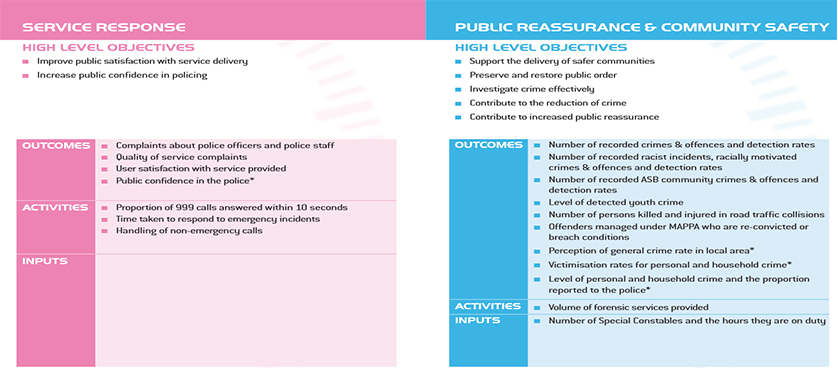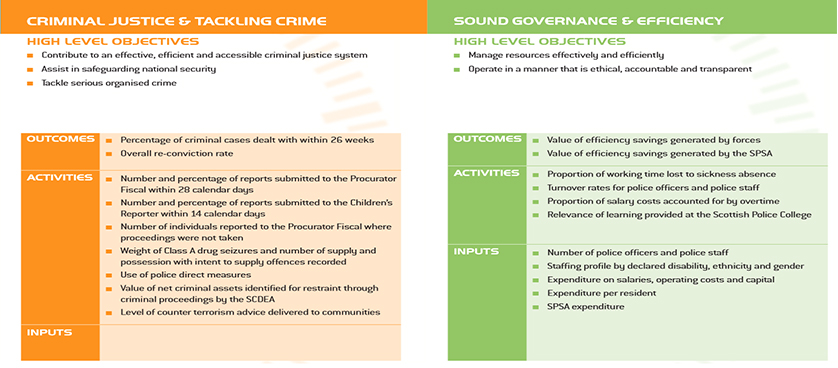Performance and target setting at Scotland Police
Ensuring public safety is the ultimate goal of any police authority. This translates into actions that have to be taken towards the achievement of this goal. Scotland Police seems to have found the way of managing these actions. In 2007, they developed The Scottish Policing Performance Framework, which ensures a national model for the measurement and reporting of performance information.
The framework is divided into 4 areas: Service Response, Public Reassurance and Community Safety, Criminal Justice and Tackling Crime, Sound Governance and Efficiency. In each of these areas, high level objectives have been set, with Key Performance Indicators (KPIs) divided into Inputs, Activities and Outcomes.
Positive aspects of the presented framework include:
- Well defined objectives – they start with a verb;
- KPIs are developed using a value flow approach, with inputs, processes and outcomes – to offer clarity at each stage of the 4 performance areas;
- KPIs cover a wide area of the police activity.
However, it is still place for improvement: KPI’s names should be standardized. For example: “Proportion of 990 calls answered within 10 seconds” should be renamed “% 990calls answered within 10 seconds”.
Traditionally, targets have to be assigned to each KPI, to trigger performance. Firstly, they are set at national level, and then cascaded to local authorities and to each police officer. However, the chief of Police Scotland claims that there are no targets set on individual officers, although there are national and local targets in place. However, in practice, officers still have to meet targets.
Andrea MacDonald, chairwoman of the west area of the Scottish Police Federation sustains that “It has become a numbers game”, which proves the contrary of the chief of Police Scotland official statement. Furthermore, a memo issued by an inspector to the Glasgow divisions was notifying the officers to use overtime “solely for the purpose of targeting stop searches”.
Such an approach can prove to be damaging, as there is the danger of rather focusing on areas where it is easier to meet targets, than on activities that require more time. For instance, if targets are set on speeding, officers will focus on the roads where it is easier to catch speeders, rather than on the roads with higher accident potential, but not that exposed to speed. Although it is not yet the case for Scotland Police, another risk of setting targets is that it can lead to gaming – manipulating figures to show improvement year after year.
Even if Police Scotland keeps claiming that individual officers do not have targets, it has refused to disclose information about its national targets and the way performance is measured at national, local and individual level, saying that “Premature disclosure of the management information would detrimentally impact on these sensitive discussions which have yet to reach a conclusion … consequently we decline to disclose further information as it would prejudice substantially, or be likely to prejudice substantially, the effective conduct of public affairs….”
This attitude raises some questions concerning the KPIs’ targets at Scotland Police. Targets can be useful, but they should be carefully set and managed. A wrong approach to target setting can lead to undesired results.
References:
- Scotland Police (2012), Scottish policing performance framework 2011/12
- The Herald (2013), Policing targets alienate public
- The Herald (2013), Police reject targets request
Image source:

Tags: Government performance, Law Enforcement, Performance Measurement, Scotland, Targets







